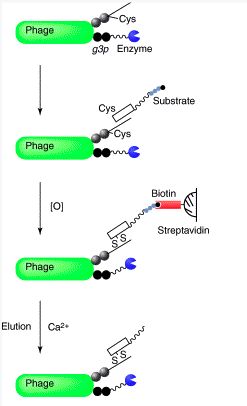Phage Display-based Enzyme Directed Evolution is a powerful high-throughput screening technique developed to enhance enzyme properties. This innovative method has greatly changed how we can improve enzymes, enabling quick evolution of these key biological catalysts to increase their efficiency, stability, and substrate specificity. Studying and understanding this process is vital because it could significantly contribute to the expanding fields of biotechnology and drug discovery.
 Phage display as a tool for the directed evolution of enzymes (Ana Fernandez-Gacio, 2003)
Phage display as a tool for the directed evolution of enzymes (Ana Fernandez-Gacio, 2003)
Service Process
Our comprehensive service process for Phage Display-based Enzyme Directed Evolution encompasses several stages:
- Initial Consultation: This is the first stage where we discuss and understand the needs and requirements of the project. This involves aligning our goals with yours and setting clear expectations for the project's outcomes.
- Detailed Project Planning: In this stage, we lay out a detailed roadmap of the project, outlining each step that will be taken in the process. This includes defining the specific objectives, resources required, and timelines for each stage.
- Construction of Enzyme Library: Once the project plan is in place, we proceed to the construction of an enzyme library. This is a crucial step as it allows us to have a wide variety of enzymes to work with in the subsequent stages.
- High-throughput Screening: This phase involves screening the constructed enzyme library at a high throughput rate. This helps us identify the most promising enzyme variants for further study and optimization.
- Enzyme Optimization: The final stage involves the optimization of the selected enzymes. Here, we work on enhancing the properties of the enzymes to meet the project's objectives. This could involve improving the enzymes' catalytic efficiency, stability, or substrate specificity.
We're here to assist you. If you have any questions, need more information, or would like to discuss a potential project, please don't hesitate to contact us. Our team is always eager to help and share our expertise.
Applications
| Application |
Description |
| Pharmaceutical Research |
Phage display-based enzyme directed evolution serves as a powerful tool in pharmaceutical research and drug discovery. It facilitates the engineering of enzymes with enhanced properties such as improved catalytic activity, stability, and substrate specificity. These optimized enzymes are crucial in the production of pharmaceutical compounds, enabling more efficient and cost-effective synthesis processes. Moreover, engineered enzymes play a pivotal role in the development of novel therapeutic agents, including biologics and small molecule drugs, by enabling the synthesis of complex molecules and enhancing the efficacy and specificity of drug candidates. |
| Industrial Biotechnology |
In industrial biotechnology, phage display-based enzyme directed evolution is employed to optimize enzymes used in various processes across diverse sectors, including biofuel production, food processing, and chemical synthesis. By engineering enzymes with improved performance characteristics, such as higher catalytic activity, substrate specificity, and stability, this method enhances the efficiency and sustainability of industrial processes. For instance, engineered enzymes enable the conversion of renewable feedstocks into biofuels and biochemicals, reducing dependence on fossil fuels and mitigating environmental impact. Additionally, in the food industry, optimized enzymes contribute to the development of healthier and more nutritious products, as well as the improvement of processing efficiency and cost-effectiveness. In chemical synthesis, engineered enzymes enable the production of fine chemicals and pharmaceutical intermediates with high selectivity and yield, paving the way for greener and more sustainable manufacturing practices. |
| Biocatalysis |
Phage display-based enzyme directed evolution is instrumental in advancing the field of biocatalysis, which harnesses the catalytic power of enzymes for chemical transformations. By engineering enzymes with tailored properties, such as enhanced activity, selectivity, and stability, this method enables the synthesis of complex molecules, chiral compounds, and pharmaceutical intermediates under mild reaction conditions. Biocatalysis offers numerous advantages over traditional chemical synthesis, including higher reaction efficiency, reduced environmental impact, and the avoidance of hazardous reagents and byproducts. Engineered enzymes derived from phage display-based techniques find applications in various sectors, including pharmaceuticals, fine chemicals, and agrochemicals, driving innovation and sustainability in chemical manufacturing. |
| Environmental Remediation |
Phage display-based enzyme directed evolution offers innovative solutions for environmental remediation by engineering enzymes capable of degrading pollutants, detoxifying contaminants, and facilitating bioremediation processes. These engineered enzymes target a wide range of environmental pollutants, including organic pollutants, heavy metals, pesticides, and emerging contaminants, which pose significant threats to ecosystems and human health. By optimizing enzyme properties such as substrate specificity, catalytic activity, and stability, this method enhances the efficiency and effectiveness of bioremediation strategies in soil, water, and wastewater treatment. Engineered enzymes derived from phage display-based techniques enable the development of sustainable and cost-effective solutions for environmental cleanup, reducing the reliance on conventional remediation methods that often involve harsh chemicals and energy-intensive processes. |
| Agricultural Biotechnology |
In agricultural biotechnology, phage display-based enzyme directed evolution plays a crucial role in addressing key challenges in crop production and plant health. Engineered enzymes are utilized to develop novel crop traits, improve plant resilience to biotic and abiotic stresses, enhance nutrient uptake and utilization, and mitigate environmental impacts. By optimizing enzymes involved in plant metabolism, nutrient cycling, and stress response pathways, this method enables the development of genetically improved crops with enhanced agronomic traits, productivity, and nutritional value. Furthermore, engineered enzymes contribute to the development of sustainable agricultural practices by reducing the reliance on chemical fertilizers, pesticides, and water resources. Phage display-based enzyme directed evolution also holds promise for enhancing the nutritional quality of crops, such as increasing the content of essential nutrients and bioactive compounds, thereby addressing malnutrition and improving human health. |
FAQs
Here is a list of frequently asked questions about Phage Display-based Enzyme Directed Evolution, covering key topics from its definition, benefits, to potential applications in different industries. If you have more specific or detailed questions, don't hesitate to get in touch with us directly.
Q: Could you provide a detailed explanation of what a phage display is?
A: A phage display is a highly sophisticated and advanced technique that is primarily utilized to study and analyze protein-protein, protein-peptide, and protein-DNA interactions. This innovative technique employs bacteriophages, which are a specific type of virus, to establish a connection between proteins and the corresponding genetic information that encodes them.
Q: Could you provide a definition of enzyme directed evolution?
A: Enzyme directed evolution is a method that has been carefully crafted by scientists. It serves to enhance and improve the properties of enzymes by simulating and replicating the natural process of evolution in a controlled laboratory setting.
Q: Why is it beneficial to use phage display for enzyme directed evolution?
A: The application of phage display in enzyme directed evolution proves to be incredibly advantageous. It enables the rapid and efficient screening of a substantial number of variants. As a result, it stands as an exceptional and unparalleled tool for the purpose of enzyme directed evolution.
Q: What are the specific properties of enzymes that can be improved?
A: Through the process of directed evolution, a wide variety of properties of enzymes can be enhanced. These include their catalytic efficiency, stability, and substrate specificity.
Q: How is the improved enzyme identified?
A: The identification of the improved enzyme is achieved through a meticulously detailed and comprehensive high-throughput screening process.
Q: Is this method applicable to all types of enzymes?
A: This method has been successfully applied to a broad spectrum of enzymes. However, its applicability may largely depend on the specific characteristics and properties of the enzyme that is under study.
Q: How long does the process take?
A: The duration of the process can vary widely and significantly. It largely depends on several factors, including the specific enzyme that is under study and the nature and extent of the desired improvements.
Q: Can this process be used for drug discovery?
A: Indeed, this process can be effectively utilized to enhance enzymes that are targeted by drugs, potentially leading to the development of more effective, potent and safe therapeutic agents.
Q: Can you guarantee that the enzyme will be improved?
A: While it's impossible to provide absolute guarantees, we pride ourselves on our strong and impressive track record of successful enzyme improvement using this method.
Q: What are the next steps after the enzyme has been improved?
A: Once the desired traits have been successfully incorporated into the enzyme, it can then be used in various application areas. These include drug discovery, biocatalysis, and many more fields.

































 Phage display as a tool for the directed evolution of enzymes (Ana Fernandez-Gacio, 2003)
Phage display as a tool for the directed evolution of enzymes (Ana Fernandez-Gacio, 2003)